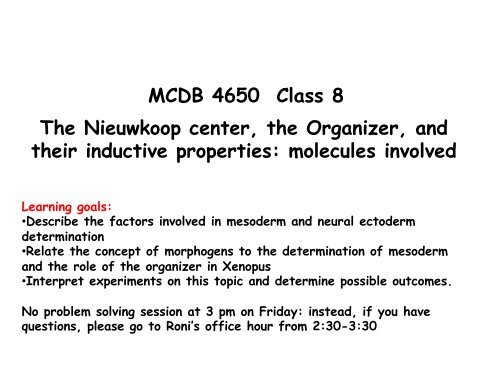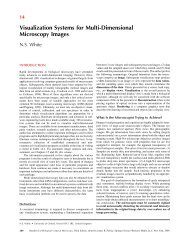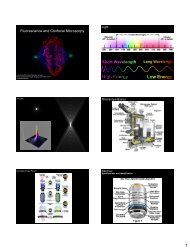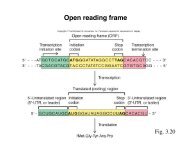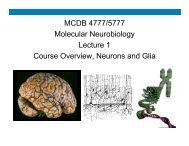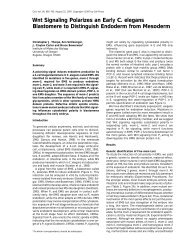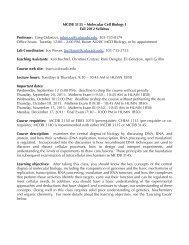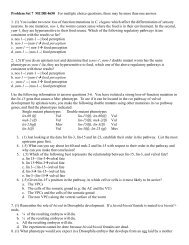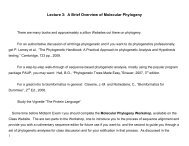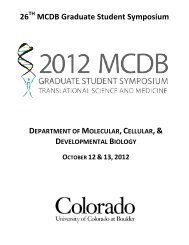Create successful ePaper yourself
Turn your PDF publications into a flip-book with our unique Google optimized e-Paper software.
MCDB 4650 Class 8<br />
The Nieuwkoop center, the Organizer, and<br />
their inductive properties: molecules involved<br />
Learning goals:<br />
• Describe the factors involved in mesoderm and neural ectoderm<br />
determination<br />
• Relate the concept of morphogens to the determination of mesoderm<br />
and the role of the organizer in Xenopus<br />
• Interpret experiments on this topic and determine possible outcomes.<br />
No problem solving session at 3 pm on Friday: instead, if you have<br />
questions, please go to Roni’s office hour from 2:30-3:30
Scientists had identified three classes of mesoderm:<br />
Dorsal<br />
Intermediate<br />
Ventral<br />
What molecules induce mesoderm?<br />
From previous experiments:<br />
• believed the signal was diffusible and likely to be a<br />
morphogen—higher concentration on dorsal side than<br />
ventral<br />
• believed the signal came from vegetal cells<br />
Find candidate proteins from the vegetal cells
What should the assays be for<br />
discovering mesoderm<br />
inducers?
Simplest:<br />
Look at<br />
phenotype<br />
of cells in<br />
culture<br />
after<br />
treatment
More sophisticated: look at molecular markers<br />
Cardiac actin, only made in heart mesoderm, is thus a marker for this<br />
type of mesoderm
How to start?<br />
Isolate proteins located (or produced) only on the<br />
vegetal side of the embryo<br />
See which of them induce which kinds of<br />
mesoderm.
Candidate molecule: activin (a TGFβ family ligand)<br />
V<br />
Activin?<br />
TGF-b family of molecules<br />
BMP, Nodal, TGF-b, activin<br />
All bind to TGF-b receptor families (dimer of type1<br />
and type 2 subunits)<br />
and activate Smad transcription factors<br />
D
In the experiment below, activin containing beads were placed in the<br />
middle of animal cap cells isolated from a blastula stage embryo.<br />
3.21<br />
Candidate molecule: activin (a TGFβ family ligand)<br />
Brachyury and goosecoid are transcription factors activated by activin
From this data, which cells are likely to express goosecoid, a<br />
transcription factor activated by high concentrations of<br />
activin?<br />
a. Ventral mesoderm<br />
b. Intermediate mesoderm<br />
c. Dorsal mesoderm
Treat isolated animal pole cells with different<br />
concentrations of activin<br />
What does this experiment tell you?<br />
a. Activin is a morphogen<br />
b. Activin can induce mesoderm<br />
c. Activin is required for mesoderm<br />
induction<br />
d. a and b<br />
e. All of the above
Is activin actually responsible for mesoderm induction?<br />
Of the following, which would you choose to<br />
demonstrate that activin was required for<br />
mesoderm induction?<br />
a. Show that activin is expressed in the embryo<br />
at the right time<br />
b. Show that activin is expressed in the embryo<br />
at the right time and in the right place<br />
c. Show that activin can induce mesoderm in<br />
culture<br />
d. Remove activin and observe phenotype<br />
e. Add extra activin and observe phenotype.<br />
Activin does induce mesoderm in vitro….<br />
but so do other molecules that may not actually be responsible for<br />
this fate in vivo
Xenopus nodal related (Xnr), also a TGF-beta ligand is<br />
the main mesoderm inducing signal
Using the kinds of experiments we just discussed, it<br />
has been shown that there is a sequence of 4<br />
signaling events that pattern the early embryo<br />
1. Vegetal pole cells to overlying marginal zone (low levels of low levels<br />
of Xnr)<br />
2. Dorsal vegetal cells (Nieuwkoop center) to overlying cells (future<br />
organizer) (high levels of Xnr)<br />
Up next: steps 3 and 4
Organizer cells make the goosecoid transcription factor<br />
Activated in cells<br />
of organizer by<br />
Xnr signals from<br />
Nieuwkoop center<br />
Smad2/4 transcription factors<br />
Only made in<br />
organizer cells<br />
Goosecoid activates expression of ligands then<br />
secreted from organizer cells
• Put together what you know:
How do the early induction processes fit together?<br />
Concept map the following terms<br />
– Dorsal vegetal cells of the blastula<br />
– Ventral vegetal cells of the blastula<br />
– Nieuwkoop center<br />
– Organizer<br />
– Ventral mesoderm<br />
– Dorsal mesoderm<br />
– Cortical rotation<br />
– Fertilization<br />
– Gastrulation<br />
– Vg1<br />
– Disheveled (Dsh)<br />
– Xnrs<br />
– B-catenin<br />
– Goosecoid<br />
Optional: try linking these terms<br />
together by position in the embryo as<br />
well:<br />
• Draw an embryo, and place the terms<br />
inside the embryo to indicate where<br />
the structures are located, or events<br />
take place<br />
• Label the axes!
Organizer cells are critical for<br />
formation of neural tissue from<br />
the ectoderm<br />
Without the organizer<br />
-no neural ectoderm forms<br />
-no dorsal mesoderm<br />
-other mesodermal fates<br />
missing as well<br />
O
1 st candidate: a gene called Noggin<br />
expressed in dorsal blastopore lip<br />
and notochord<br />
Increased concentrations of<br />
noggin increased the amount<br />
of dorsal structures
Two more groups of researchers were also looking for the<br />
neural inducing factor at the same time (early 1990s)<br />
– Differential screen for<br />
genes activated by<br />
goosecoid pulled out<br />
chordin<br />
– Looking for mesoderm<br />
inducers… found<br />
follistatin, a factor<br />
that inhibited activin<br />
Chordin expression
The 3 candidates (Noggin, Chordin, Follistatin)<br />
are all TGF-beta ligands<br />
So, scientist blocked the TGFb receptor in oocytes<br />
to see what would happen to the animal cap cells<br />
(some of which should make neural ectoderm).
San<br />
This experiment suggests:<br />
es<br />
a. TGFb ligands are required for neural differentiation<br />
b. TGFb ligands are not required for neural differentiation<br />
Mutant TGFb receptor mRNA<br />
(dominant negative)<br />
Neural tissue
Another experiment supported these findings: when animal<br />
cap cells were dissociated in culture, they made neural<br />
tissue on their own<br />
Why?
Remove all BMP from the embryo, and<br />
the embryo makes only neural<br />
ectoderm, no epidermis
normal<br />
BMPs inhibited<br />
with antisense<br />
oligos<br />
Sox-2 expression<br />
(a neural gene)<br />
Chordin, noggin<br />
follistatin<br />
inhibited with<br />
antisense oligos<br />
BMPs and ADMP<br />
inhibited
Which of the following sums up the evidence?<br />
a. BMPs secreted in the late blastula block nonneural<br />
fate<br />
b. Molecules secreted by the organizer in the early<br />
blastula stage are inhibited by BMPs<br />
c. Molecules secreted by the organizer in the late<br />
blastula stage inhibit BMP signaling to allow<br />
neural fate<br />
d. Molecules secreted by organizer induce neural<br />
fate from otherwise non-neural cells
Step 3: secretion of “organizer<br />
molecules” : inhibitors of BMP<br />
Step 4: secretion of BMP from ventral<br />
mesoderm
The default fate<br />
of the ectoderm<br />
is neural<br />
The organizer<br />
induces by<br />
inhibiting an<br />
inhibitor<br />
(BMPs)<br />
Sanes, Reh and Harris, 2000
Animal cap cells not committed at blastula stage, but are by<br />
gastrulation
Summary<br />
• BMPs are present throughout the embryo at the<br />
blastula stage, but downregulated on the dorsal<br />
side by organizer (including by goosecoid)<br />
• The BMP blockers, Noggin (and related molecules),<br />
are secreted before gastrulation, defining neural<br />
ectoderm and intermediate mesoderm.<br />
True in all vertebrates, and many invertebrates as well
What would happen if you removed all<br />
chordin from the Xenopus embryo?<br />
a. no mesoderm could form<br />
b. no neural ectoderm could form<br />
c. no non-neural ectoderm could form<br />
d. no obvious effect
Assume that you can ectopically express<br />
(ectopically=express in a different area) chordin on the<br />
ventral side of a Xenopus gastrula stage embryo. What will<br />
happen?<br />
a. Extra neural structures<br />
b. Extra dorsal mesodermal structures<br />
c. Extra endodermal structures<br />
d. Extra neural and dorsal mesodermal structures<br />
e. Extra neural, dorsal mesodermal and endodermal<br />
structures
Which of the following is NOT true of the cells of<br />
the organizer?<br />
a. Induces gastrulation<br />
b. Inhibits epidermal fate<br />
c. Converts ventral mesoderm to intermediate<br />
mesoderm<br />
d. Involutes through the dorsal lip of the blastopore<br />
e. Becomes intermediate mesoderm—cells that make<br />
up kidney, other organs central to the body


